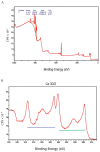Cerium Oxide Enhances the Toxicity of Zinc Oxide Nanoparticles in Human Lung Epithelial Cell Cultures
- PMID: 36136487
- PMCID: PMC9502999
- DOI: 10.3390/toxics10090522
Cerium Oxide Enhances the Toxicity of Zinc Oxide Nanoparticles in Human Lung Epithelial Cell Cultures
Abstract
Recently, many approaches have been developed to improve the performance of nanomaterials. Combining more than one nanomaterial is one such approach that achieves superior results. However, during the fabrication of nanomaterials or formulation of end products, materials can be released into the ambient air and be inhaled by workers. The adverse health outcomes of inhaling such compounds are unknown. In this study, we examined such effects in combining two of the most utilized nanomaterials in several industrial sectors: zinc oxide (ZnO) and cerium oxide (CeO2). These materials can be found together in sunscreens, polyvinyl alcohol (PVA) films, and construction products. The aim of this study was to assess the adverse biological outcomes of CeO2-ZnO nano-mixtures in human lung epithelial cells. A549 human lung epithelial cells were treated with increasing concentrations of ZnO or CeO2 NPs alone, or as a mixture of both, under submerged conditions for 24 h. After treatment, cell viability, reactive oxygen species (ROS) formation, cell membrane integrity, and cytokine production were examined. ZnO NPs showed a dose-dependent trend for all endpoints. CeO2 NPs did not exhibit any toxic effect in any individual concentrations. When higher doses of ZnO were combined with increasing doses of CeO2, loss of cell viability and an elevation in cell membrane leakage were observed. Interleukin 8 (IL-8) and ROS generation were higher when ZnO NPs were combined with CeO2 NPs, compared to cells that were treated with ZnO alone. The release of monocyte chemoattractant protein-1 (MCP-1) was reduced in the cells that were treated with higher doses of ZnO and CeO2. Thus, the presence of CeO2 enhanced the toxicity of ZnO in A549 cells at non-toxic levels of CeO2. This suggests an additive toxicity of these two nanomaterials.
Keywords: cerium oxide; lung epithelial cells; nanoparticles; nanotoxicology; tissue culture; zinc oxide.
Conflict of interest statement
The authors declare no conflict of interest.
Figures







References
-
- Khanna I., Kumar A. Including nanoparticle mixtures in human health risk assessment. Integr. Env. Assess. Manag. 2014;10:144. doi: 10.1002/ieam.1498. - DOI
-
- Tomak E., Yazici O., Sam Parmak E., Gonultas O. Influence of tannin containing coatings on weathering resistance of wood: Combination with zinc and cerium oxide nanoparticles. Polym. Degrad. Stab. 2018;152:289–296. doi: 10.1016/j.polymdegradstab.2018.03.012. - DOI
-
- Chandrakala H.N., Ramaraj B., Shivakumaraiah, Madhu G.M., Siddaramaiah The influence of zinc oxide–cerium oxide nanoparticles on the structural characteristics and electrical properties of polyvinyl alcohol films. J. Mater. Sci. 2012;47:8076–8084. doi: 10.1007/s10853-012-6701-y. - DOI
-
- McMahon S. 6 Destinations with Sunscreen Bans, and What You Need to Know. [(accessed on 26 March 2020)]. Available online: https://www.smartertravel.com/sunscreen-ban-destinations/
Grants and funding
LinkOut - more resources
Full Text Sources
Research Materials
Miscellaneous

